Throughout your childhood you were most likely told many times to “sit up straight!”. You probably didn’t understand why. Your mother, teacher or whoever was giving you these instructions probably didn’t know themselves. As it turns out, the biggest reason why this is so important revolves around your posture – the forces you are placing on your muscles and joints; and the messages you are training your brain (neural system).
In our typically western lifestyle, where most jobs demand prolonged sitting at a desk and computer, postural dysfunction is a significant problem and has huge consequences for injury and pain. Prolonged sitting can be detrimental to your health.
Why is your posture so important?
Good posture has positive physical implications, meaning we sit and stand up naturally with optimal curves of your spine; as opposed to being slumped or slouched. There are important internal and functional benefits that arise from good posture; however, what we can assess physically tells the story of these deeper implications. Posture affects how we walk, run, lift weights and complete other everyday tasks, while good posture ensures no bodily structure is overstressed. Because of this, correct posture ensures you look and feel good.
Correct posture ensures bones and joints are kept in alignment, resulting in correct and efficient use of your muscles. Efficient movement is important to reduce the wearing of joint surfaces that can lead to arthritis and joint pain. Correct posture and alignment ensure your muscles work efficiently, reducing energy use and muscular fatigue. A positive benefit of this is a reduction in the mechanical stress placed on the ligaments holding your joints together, thus minimizing the risk of injury!
Good posture helps to prevent muscular pain, lower back pain, and neck pain. Poor posture increases the mechanical stress on the spine. This can lead to constricted blood vessels and nerves, which will likely result in restricted blood flow, pain, and muscle weakness.
There are various types of postural issues that can arise throughout the body. We will highlight two of the most significant and common spinal postural problems we see as Accredited Exercise Physiologists;
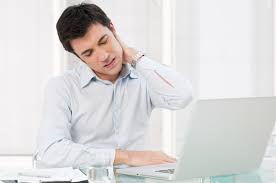
Common Postural Dysfunction
- Lumbar lordosis
What is it and what causes it?
Everyone has a natural lordotic curve, however, if your curve arches too far inwards it is termed lordosis. Lordosis often stems from prolonged hours of sitting and not stretching, in which hip flexors become tight. It may also arise from conditions such as osteoporosis or obesity. As aforementioned, this often arises from tight hip flexors and is therefore associated with anterior pelvic tilt. Anterior pelvic tilt refers to when the front of the pelvis drops and the back of the pelvis rises. This occurs when hip flexors tighten, while hip extensors including the hamstrings and glutes, as well as abdominal muscles, lengthen. These muscular imbalances contribute to the pelvic drop and lordosis, which will often contribute to lower back pain and discomfort. If left untreated, low back pain can persist while nerve problems may arise.
How can I correct this?
Fortunately, there are always ways to begin correcting your posture. Stretching and performing release work on the hip flexors will aid in correcting pelvic tilt. Below are some images of some of these.
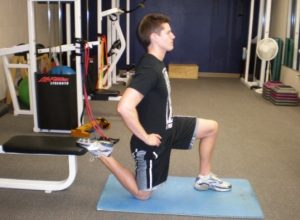
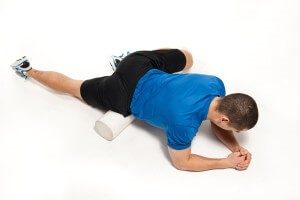
Myotherapy treatment can assist with improving muscle range of movement and reduce posture related pain.
Furthermore, strengthening the glutes, hamstrings and abdominal muscles will also assist in pulling the pelvis into proper alignment, thus improving lordosis, as well as the pain and functional limitations associated with it. As discussed, tightening or strengthening the abdominal muscles will also assist in correcting this, as core strength is essential in maintaining or correcting posture! A good exercise to try is ‘dead bugs.’ This is an exercise we often use with clients at Inspire Fitness, as it is a great core strengthening exercise, while we can also focus on correcting lordosis via correct spine alignment throughout. While in this position, we often have clients extend one arm and their alternate leg for a number of repetitions. As an example, a client with lordotic tendencies will tend to lift their back off the ground during this exercise, due to the increased arch of their spine and anterior pelvic tilt. By placing our hand below their lumbar spine and asking them to press down on it throughout the exercise, their spine and pelvis are brought into correct alignment, which is held throughout the exercise. Immediately upon pushing your lower back into the ground, you will feel the contraction in your abdominals, which is perfect for what we are trying to achieve!
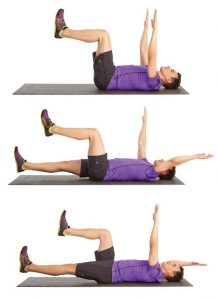
2.Thoracic Kyphosis
What is it and what causes it?
Kyphosis, also known as hunchback, is a condition where the spine segment in the upper back has an excessive curvature resulting in this ‘hunch’ and rounded shoulders. Similarly, this occurs with prolonged hours of sitting, this time in a poor posture, with a rounded back and forward shoulders over your desk or computer. Contrary to lordosis, thoracic kyphosis is associated with a posterior pelvic tilt, where the front of the pelvis rises and the back of the pelvis drops. This occurs when the hip flexors lengthen and the hip extensors, such as the glutes and hamstrings, shorten. Thus, the pelvis is pulled downward by these hip extensors.
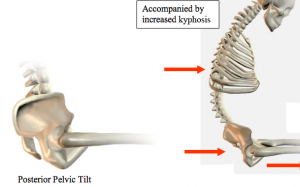
How can I correct this?
Approaches to correct this postural defect include relieving chest tightness via self-myofascial release, a condition that occurs with kyphosis thus pulling the shoulders forward. Furthermore, prolonged sitting at a desk in this slouched position will often result in a tight serratus anterior (SA), a muscle responsible for protracting the shoulder blades. Hence, a tight SA will contribute to this postural defect, while exercises such as pullovers to counteract this, can aid in returning the shoulder blades to their natural position (Refer to; Strength training for the deep stabilizing muscles)
With this, come weaker and looser back extensor muscles. It has been found that strengthening back muscles such as the rhomboids means they are better able to counteract the forward pull on the spine. Hence, exercises that strengthen these muscles, such as seated cable rows, can decrease the angle of kyphosis. Furthermore, releasing tight hamstring muscles and glutes, while strengthening the weaker, counterbalancing quadriceps and psoas muscles will assist in correct posterior pelvic tilt.
At Inspire Fitness we use corrective exercise with your personal training and exercise physiology in combination with general fitness training to ensure you maximize the results from your exercise. Our assessment process will specifically analyse any potential postural defects that we can design your individually tailored program around.
Please contact us on 9857 3007 if we you are experienceing pain from poor posture. Ask any of our personal training team if you are confused with these corrective exercises.
References:
https://www.healthline.com/health/lordosis#types
https://www.medicalnewstoday.com/articles/317379.php
https://www.healthline.com/health/posterior-pelvic-tilt
